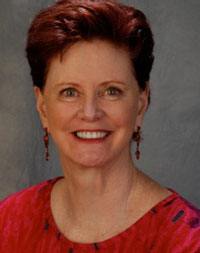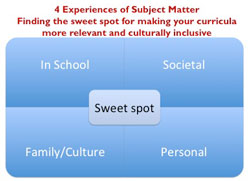by Sue O’Halloran
 In order to make curricula more relevant to the vast array of cultures represented in our classrooms, teachers and artists need to look for the “sweet spot” where four areas of learning can overlap:
In order to make curricula more relevant to the vast array of cultures represented in our classrooms, teachers and artists need to look for the “sweet spot” where four areas of learning can overlap:
- The core curricula for a subject
- The individual interests, motivations, personality, learning styles and communication styles of each student
- The family and community context in which the student lives – what students already know and learn outside of school and bring to the classroom with them as a way they understand and experience their lives
- The sociopolitical, economic and historical context in which students and their families and communities live
The more time teachers can spend in the sweet spot, students are more engaged because they feel seen, valued and respected. Put simply, students do not learn if they don’t feel they belong Lucky for us, storytelling plays a huge role in bringing a sense of belonging and being cared for into each of these four areas.

For this short article, let me give a few examples of bringing stories into junior and high school subject areas, that, unlike English or social studies class, we might not think to use storytelling:
In math class for family and community context, students can investigate:
- What did things cost when your parents and grandparents were growing up?
- If your family lived in a country outside of the U.S., what form of money did they use?
- Compare inflation rates and conversion rates when your parents were children to today’s rates.
For physical education and health:
- What games and sports did/does your family play?
- When you get sick how are you taken care of?
- What health remedies does your family use? How have they changed over time or when moving to another country?
These real world applications are essential for involving students because they value the students’ current knowledge base and recognize the immediate world the students inhabit.
Science, math and any other subject need not only be strict transfers of knowledge about proven theories and principles. They can also be an integrated reflection of how people view and function in the world. We always want to give our students mirrors -where they see themselves and their families reflected in respectful ways – and windows -where they come to understand all the different ways people live, make sense of their lives and survive and thrive. To investigate the larger sociopolitical, economic and historical context for math and science, for example, a class might explore:
- Tell the story of one day in the life of a family of four in our town who are living on two minimum wage salaries and what they do to make ends meet. Include their budget for shelter, food, utilities and day care.
- Tell about a moment of decision from the point of view of a child living in a dwelling other than a “house”. Include the home’s shape, size, floor space, amount of private and communal space.
- Tell the story of a community leader who takes a stand for the air and water quality in her neighborhood. Include how the decision was made to locate a toxic dump near her home.
This is just a small snippet of ways teachers and artists can make their teaching more relevant and engaging. Some of the most challenging work, however, is the introspection educators must do on themselves. Cultural relevancy isn’t just about adding other cultural references but also understanding our cultural lens and our subject matter from new perspectives: For instance,
- What was I taught about other group’s families, communities, history and ability to achieve? How much connection do I have now with the communities in which my students live?
- How has literacy in your subject been a gatekeeper to educational and personal success?
- How do issues of race and class affect the teaching and learning of your subject?
It is not easy to teach what we may have never learned or to examine the ways our beloved subject matter may have added to our country’s exclusion, but the effort is well worth it when you see the look in students’ eyes that says, “Yes, this subject is about me, my family and my world! I love learning!”
Come learn more about this topic at Sue’s workshop at the 2016 National Storytelling Conference, July 21-24, in Kansas City, Missouri. www.storynet.org/conference
About Sue
Susan O’Halloran has been seen on PBS, ABC Nightline and in the New York Times, Boston Glove and Chicago Tribune. Sue has presented over a dozen times at NSN conferences and is a recipient of NSN ORACLE Leadership and Service and Circle of Excellence Awards. She brings a comprehensive 7 Step Program to organizations who are serious about avoiding strained relationships plus PR nightmares from “incidents” and the possibility of harassment and discrimination suits.
Sue has videotaped over 170 social justice stories by professional storytellers and produced the first online storytelling festivals that had a Facebook reach of over 112,000 and where people in over 50 different countries participated.
